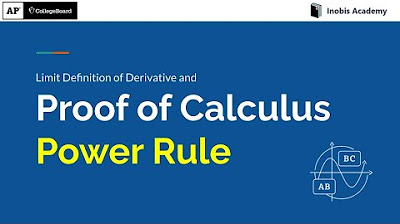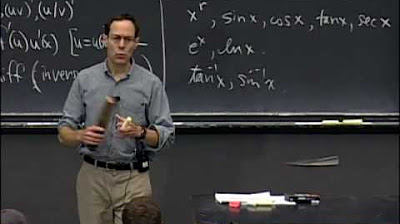BusCalc 09 Why the Power Rule?
TLDRThis educational video dives into the intricacies of the power rule in calculus, specifically aimed at demystifying its application in deriving polynomials. The instructor begins with a foundational proof for when the exponent is one, demonstrating through the definition of a derivative how the rule holds. The discussion progresses to a general proof using mathematical induction, methodically proving that if the rule is valid for an exponent k, it also applies to k+1. This approach methodically confirms the power rule's validity across all natural numbers, enriching viewers' understanding without requiring memorization.
Takeaways
- 📚 The video aims to explain the power rule for derivatives of polynomials, satisfying student curiosity rather than being a requirement to memorize.
- 🔢 The power rule states that the derivative of x to the power n is n times x to the power (n-1), where the exponent decreases by 1 and becomes the coefficient.
- 📈 The video provides a proof by induction, starting with the base case where n equals 1 and showing that the derivative of x to the power 1 is indeed 1.
- 📌 The proof uses the definition of the derivative, which involves a limit as h approaches 0, and applies it to the function x to the power 1.
- 🔍 The process simplifies the limit expression step by step, showing that the derivative of x to the power 1 is a constant number 1, confirming the power rule for n=1.
- 🔁 The inductive step assumes the power rule is true for n=k and aims to prove it for n=k+1, which would extend the rule to all natural numbers.
- 🎯 The function f(x) = x to the power (k+1) is considered, and the power rule is shown to hold for this function, assuming it holds for x to the power k.
- 🧮 Algebraic manipulation is used to expand and simplify the expression for the derivative, factoring out common terms and using the properties of limits.
- 📉 The video breaks down the limit into separate parts, evaluating each part individually and using the assumed power rule for x to the power k.
- 🔗 The final expression derived for the derivative of x to the power (k+1) matches the power rule's prediction, proving the rule for n=k+1 given it holds for n=k.
- 🌟 The proof concludes that the power rule works for all natural numbers n, starting from n=1 and using the inductive step to extend its validity.
Q & A
What is the power rule in calculus?
-The power rule is a basic derivative rule that allows us to find the derivative of functions of the form f(x) = x^n. According to the power rule, the derivative of f(x) is f'(x) = n*x^(n-1), where n is the exponent and x is the base of the term.
Why is the power rule considered important in calculus?
-The power rule is crucial because it provides a straightforward method to calculate the derivatives of polynomial functions, which are foundational in mathematical analysis, physics, engineering, and economics. Its simplicity and general applicability make it a fundamental tool in differential calculus.
What is meant by 'proof by induction' in the context of the video?
-Proof by induction is a mathematical technique used to prove a statement is true for all natural numbers. It involves two steps: proving the base case (often n=1) and then proving that if the statement holds for an arbitrary number k, it also holds for k+1. This method is used in the video to demonstrate.
Outlines
🧐 Introduction to the Power Rule for Derivatives
This video explores the reasons behind the effectiveness of the power rule for derivatives, primarily used in polynomial differentiation. The presenter emphasizes that the content is intended to satisfy curiosity rather than for memorization. The rule's mechanics are introduced by starting with the simplest case where the exponent is one. Using the definition of derivatives, a step-by-step explanation is provided to show why the derivative of x to the power of 1 is 1, preparing the viewers for a more in-depth exploration of the rule.
🔍 Demonstrating the Power Rule's Validity for n=1
The session proceeds to mathematically prove the power rule's accuracy when n equals 1 by using the limit definition of the derivative. A calculation is performed to show that the derivative of x (when x is raised to the power of one) is indeed 1, as per the power rule. This example serves as a stepping stone to introduce the concept of mathematical induction, which will be used to extend the power rule's validity to any positive integer.
🤔 Exploring Mathematical Induction
The power of mathematical induction is introduced as a tool to extend the validity of the power rule across all natural numbers. By assuming the power rule holds for a given n equals k, the video prepares to demonstrate it also holds for k+1. Initial algebraic simplifications are performed, preparing the stage for a deeper dive into the intricate algebra involved in proving the rule for k+1.
🧩 Breaking Down Complex Algebra
Complex algebraic manipulations are carried out to rigorously prove the power rule for k+1. The presenter reorganizes terms and utilizes factorization to simplify the expression, illustrating how algebraic techniques can reveal deeper insights into the derivative's behavior. By breaking up the limit into simpler components and using properties of limits, the proof moves closer to conclusion.
✅ Verifying the Power Rule's General Application
The final segment confirms that the power rule holds for n equals k+1, leveraging the induction step established earlier. This comprehensive verification shows that starting from n equals 1, the rule is applicable to any subsequent natural number, thereby proving the rule's general validity. The video concludes with a recap of the proof process, affirming the reliability of the power rule in calculus.
Mindmap
Keywords
💡Power Rule
💡Derivative
💡Induction
💡Polynomials
💡Limit
💡Natural Numbers
💡Coefficient
💡Algebraic Manipulation
💡Function
💡Proof
Highlights
The video explores why the power rule for evaluating derivatives of polynomials works.
The power rule states that the derivative of x^n is n*x^(n-1).
The video provides a proof by induction that the power rule holds for any natural number n.
The base case is proven where the power rule holds for n=1, resulting in a derivative of 1.
The inductive step assumes the power rule holds for n=k and aims to prove it also holds for n=k+1.
The derivative of x^(k+1) is found by using the definition of the derivative and algebraic manipulation.
Factoring out x from the numerator terms and canceling h from the numerator and denominator simplifies the expression.
The derivative of x^k is assumed using the induction hypothesis that the power rule works for n=k.
The derivative of x^(k+1) is found to be (k+1)*x^k, confirming the power rule for n=k+1 given it works for n=k.
The proof shows that if the power rule works for n=1, then it also works for n=2, 3, 4, ... and any natural number n.
The proof is by mathematical induction, proving the base case and then the inductive step.
The video emphasizes the proof is not something that needs to be memorized, but rather to gain an appreciation for why the power rule works.
The video is more technical than others in the course, but students are encouraged not to panic if it goes over their heads.
The proof uses algebraic manipulation and the properties of limits to derive the power rule for n=k+1 based on n=k.
The video provides a rigorous mathematical proof that the power rule holds for any natural number exponent.
The proof is a satisfying explanation for students curious about the mathematical reasoning behind the power rule.
The video concludes that the power rule is proven to work for all natural numbers n, providing a solid foundation for this important calculus concept.
Transcripts
Browse More Related Video

Proof of the Calculus Power Rule using the Limit Definition of a Derivative.

Proof by Mathematical Induction | Principle of Mathematical Induction | Sample Problems | Part 1

Proof by Mathematical Induction (Precalculus - College Algebra 73)

Calculus - How to find the derivative of a function using the power rule

Lec 7: Exam 1 review | MIT 18.01 Single Variable Calculus, Fall 2007

Proofs of derivatives of ln(x) and e^x | Taking derivatives | Differential Calculus | Khan Academy
5.0 / 5 (0 votes)
Thanks for rating: